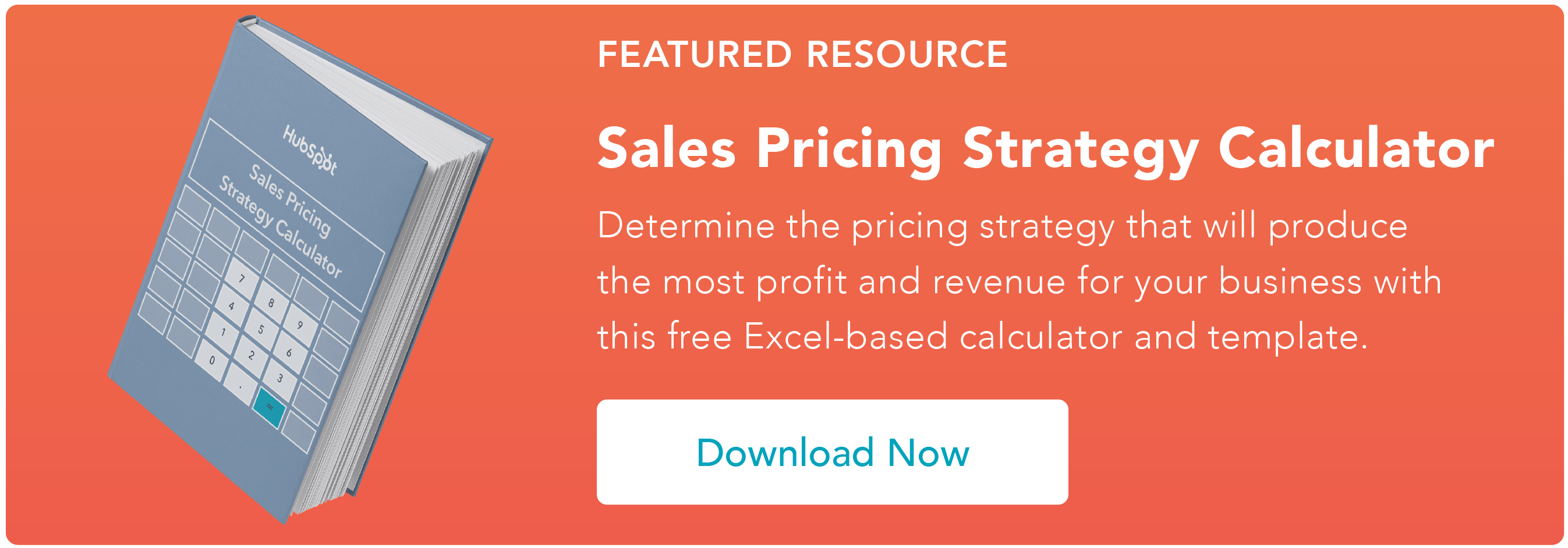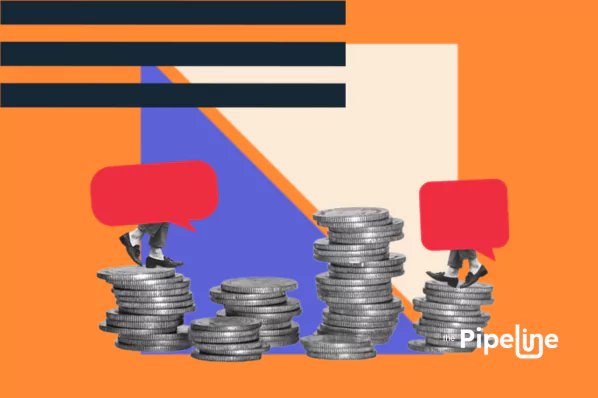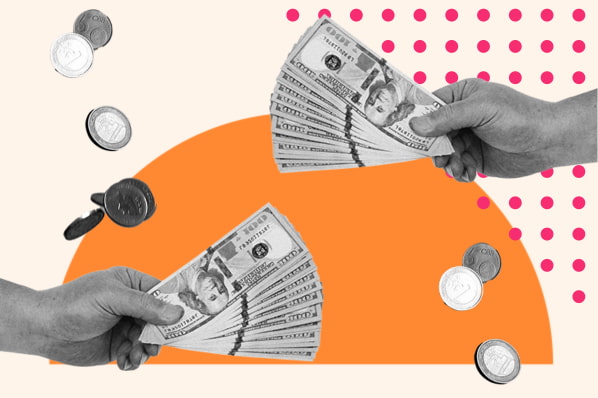Ever wonder why milk is so inexpensive? It's a staple in most American homes, so why isn't it conveniently up front?
Without even knowing it, you've encountered a loss leader pricing tactic.Loss leader pricing is a practice businesses use to price certain items — like bread or milk — below the cost it takes to produce them in order to bring buyers into the store and entice them to purchase other items — like, say, cereal, a candy bar, and some laundry detergent.
It's a smart strategy, especially since recent surveys have found the average consumer spent $182.98 on impulse buys per month. That's over $2,000 per year!
Let’s take a look at the types of loss leader pricing, some advantages and disadvantages of the practice, and finally, a few examples of businesses that employ this strategy.
Download Now: Free Sales Pricing Strategy Calculator
Loss Leader Pricing
Loss leader pricing is a strategy in which a seller marks a product or service for sale below cost to attract buyers into their online or physical store. According to the strategy, the loss leader item is sold at a loss, but the business expects customers to purchase other items at regular price, thereby negating the loss.
This strategy is commonly used by retailers but can be used by professional and software services as well.
Types of Loss Leader Pricing Strategies
Pricing strategies are rarely a one-size-fits all approach in the world of retail sales. (That is unless you’re Dollar Tree — more on them in a moment). Most stores need a variety of pricing strategies to compete in the market, appeal to a wide target audience, and increase sales. While the loss leader strategy is a straight-forward concept, there are several ways businesses execute this play.
Introductory Pricing
Introductory pricing is a type of loss leader pricing where a company entices buyers to purchase an item by offering a discount upfront, then charging the regular price later. Think of this as the “Why not? Let’s try it” approach. This benefits the company because they’re more likely to get new business by marketing a few items at a lower price. It’s not a bait and switch, though. Customers benefit from this, too. They get to try out the product at a lower rate before deciding to commit to the purchase for a longer period of time.
Store Placement
Why is it that on the day before Thanksgiving, the walk to the dairy aisle to get that gallon of milk for the mac and cheese seems so much further away than usual? That’s because it is, kind of. Grocery stores place milk in the back of the store for a few reasons, one of them being loss leader pricing. Milk and eggs are some examples of loss leader items, and they’re good choices for this strategy. These items expire quickly, and a lot of customers purchase them regularly, so pricing them at a loss isn’t going to break the bank for a grocery store. If customers walk past items that are priced at a profit on their way to the milk, they’re more likely to see something else they want to buy. Store placement works for loss leaders because it makes up for the loss of profit on milk with the profit from, say, the Oreos on the endcap of aisle two.
Inventory Management
In some industries, inventory management is just as important as proper pricing. A loss leader strategy ties both of these goals together to turn a profit. Many industries have inventory that simply won’t sell if it’s out of season, expired, or less valued by the market the older it gets. By pricing these older items at a price close to or lower than cost, businesses can attract more customers who are motivated to buy at the lower price. This influx of purchases quickly clears out older inventory items to make way for fresher products that can be sold at within a profitable margin.
Free Samples
Who doesn’t love free stuff? Free samples are the quintessential loss leader. Stores offer customers free samples to build an affinity for the brand and the product. This tactic applies a phenomenon called the reciprocity principle. This is a principle of social psychology that suggests when people are offered a favor, they’re more likely to reciprocate it. Therefore, taking a free sample might make customers feel obligated to buy the product. We’re social creatures who thrive on cooperation, and free samples are just one way that cooperation works to turn a profit for businesses (and gets that new flavor of watermelon Oreos in your pantry).
Advantages to Loss Leader Pricing
Now that we know what loss leader pricing is and why businesses use it, let’s dig into some advantages of the strategy.
Breaking Into a New Market
Barriers to entry in a market can be tough to overcome, but loss leader pricing can make tackling that obstacle a bit easier. In monopolistic companies that have similar, but not identical products, pricing your product below the competitors’ price can be an effective way to break into the market and acquire customers.
Increasing Sales
Advertising loss leader items brings more traffic to businesses. Ideally, people will buy additional items or forgo the purchase of a loss leader entirely to purchase another item that is priced at a profit. Increasing foot traffic with enticing loss leaders can create more visibility for products that are regularly priced, thus increasing sales.
Brand Loyalty
Depending on a business’s brand positioning, offering value at a low cost could contribute to brand loyalty from customers. If customers know that the prices at a particular store will be the lowest of the competition, and if that’s important to them, they’ll be repeat customers.
Problems with Loss Leader Pricing
Too much of a free thing can be costly. From customers adjusting their shopping habits to predict the next sale to running out of stock, loss leader pricing comes with obstacles. Here are some challenges to loss leader pricing.
Cherry Picking
When buyers purchase a loss leader product without buying other goods, this is called cherry picking. It’s one of the downsides of loss leader pricing. These buyers might visit several online or physical stores purchasing loss leaders at each but never buying another item.
The danger for these businesses is that they experience a loss that is not offset by the purchase of other merchandise. If buyers continue to cherry pick, businesses may lose too much money and face financial hardship.
To guard against this, purveyors of loss leader pricing often set quantity limits for loss leader items. For example, a retailer might limit one loss leader television per person or cap a loss leader discount to the first 100 people in line.
Waiting
If a business doesn’t plan loss leader pricing well, customers might begin to predict when they’ll drop prices and wait for that time to arrive before making a purchase. Not only is this bad for sales, it can decrease the value of a brand. Customers will view a company as a place to go only during a sale rather than a place to go anytime they need a product.
To avoid this pitfall, businesses keep a tight lid on promotions until they’re ready to market loss leader items.
Stocking Issues
Poorly forecasted loss leader sales can quickly deplete a store's stock of products. Think of this from two perspectives. First, the stock of the loss leader items could be depleted quickly if the demand outpaces supply for the product. Second, the stock of other popular items might deplete quickly as a secondary effect of the loss leader pricing working to increase sales of profit-priced items.
To maintain adequate stock levels of products, this type of pricing strategy should be planned in conjunction with merchandising, marketing, and supply chain teams before being promoted to the market.
Brand Perception
On the opposite end of the brand perspective, loss leader pricing can tarnish a company’s reputation if the target audience doesn’t want or expect steep discounts from a particular business. Luxury goods and real estate might see adverse effects from loss leader pricing. Buyers may wonder why a normally expensive item is suddenly discounted and assume a lack of quality might be the culprit.
Impact on Manufacturers
If a retailer prices a product as a loss leader, they’ll likely draw quite a bit of business away from competitors who sell the same product at a higher price. This negatively affects the manufacturer/supplier who sees the volume of orders from non-discounting retailers drop and an increase in volume from the loss leader retailer rise. This places stress on manufacturer/retailer relations and can lead manufacturers to lower prices when they otherwise wouldn’t have.
Impact on Small Businesses
Loss leader pricing often benefits large corporations that can afford to take a loss on some products or services to enjoy gains on other items. Small or local businesses most often get the short end of the stick in this scenario, as they can’t afford to cut prices so steeply.
Legal Issues
Loss leader pricing has been banned in some U.S. states including Oklahoma, California, and Colorado. However, in some states, it's only partially banned, and in Oregon, Texas, and New Mexico, it's legal. Australia and Europe have also banned the practice.
Loss Leader Pricing Examples
The brands we know and love have used the loss leader pricing strategy to lure us in to make impulse purchases. It’s worked like a charm for Netflix, but not so much for Subway. Read on to find out why.
Gillette
Gillette has practiced loss leader pricing by selling its mechanical razors below cost. These blades didn’t have a long life and needed to be replaced soon after buyers received their low-cost razors. They purchased replacement blades and other Gillette products, thus completing the loss leader sales cycle.
Subway
Subway’s $5 footlong is an example of loss leader pricing that overstayed its welcome in the market. The infamous $5 footlong transformed the brand from just-another-sub-shop into an affordable any-time meal. What worked for Subway was the variety of sandwiches that customers could choose from. The variety was so large, however, that it cannibalized the profits of subs that were more expensive. The key to a loss leader pricing strategy is this: items priced at a profit have to make up for the items priced at a loss. In Subway’s case, that didn’t happen. While the fresh sub shops are still around today, their sales have drastically declined in the years since the $5 footlong era ended.
Costco
Megastore Costco is beloved by families across the United States for their bulk options and low prices for house-hold favorites. Because these stores are placed sparsely, families make the most of their time by setting aside an hour or more for the trip. Costco knows this and instituted a loss leader-priced offering $1.50 hotdog combos complete with a large soda. That’s a price that can’t be beat in any fast food chain. This loss leader works as you’d expect it would — it gives families an incentive to shop there for a longer time if they know they can have an inexpensive bite to eat while shopping. An underlying factor to this loss leader is the perceived value of items at Costco. If they can afford to sell you a $1.50 hotdog combo, they must be saving you a lot more money on that 48-count pack of Tic Tacs.
Rita’s Italian Ice
Rita’s Italian Ice is a seasonal frozen dessert franchise in east coast cities. Because the stores are only open for about eight of the twelve months each year, they rely heavily on brand awareness to increase their foot traffic in stores throughout the months they are open. One way they do this on a corporate-wide level is by offering free Italian ice to celebrate the first day of spring — the day most franchises open for the year. Positioning this loss leader promotion around a day that is familiar to everyone, Rita’s aligns its product to its audience at the perfect time. They’ll remember the kindness of the free sample and likely return to purchase one at regular price throughout the year.
IKEA
Known for being a maze, IKEA has strategically executed loss leader pricing through smart store placement. The items in this store range from less than $5 to well over $2,000, but by placing them close to each other in the showroom, customers are likely to make more purchases. For example, a bedroom showroom in IKEA might feature a $200 bed frame, a $500 mattress, and a unique-looking $25 lamp. You came in for a bed, but the lamp draws your attention and the price is relatively cheap compared to the $700 mattress and frame. If you were already planning to buy the mattress and bed frame, what’s another $25 for the lamp?
Toyota
The best time to buy a car is at the end of the year, specifically in December. The reason why is due to — you guessed it — loss leader pricing. Toyota’s goal is to clear out old inventory at the end of the year to make room for new inventory. Attracting an influx of customers to the dealerships to buy that old inventory at a steep discount is sure to do the trick. Toyota isn’t the only automotive brand to use loss leader pricing though; Subaru, Honda, and even luxury brands like BMW execute this strategy to manage their inventory.
Netflix
Netflix is popular in its own right, but did you know that they use the loss leader strategy to bring in thousands of customers each year? By offering a 30-day trial, the company is giving away a free month of movies and shows (shows they still pay royalties to stream) in hopes that customers will keep the recurring subscription. This is a form of introductory pricing to give customers a trial-run of the product before they commit to it.
Dollar Tree
An obvious, but exceptional example of a company using the loss leader strategy is Dollar Tree. The strategy is obvious in their tagline — “everything is $1.” With a price like this, how does Dollar Tree make money? It’s not in the traditional way that most loss leaders do. Dollar Tree doesn’t have more expensive products to make up the loss. In fact, Dollar Tree doesn’t lose money at all. The secret lies in the size of their products they sell and their buying strategy. Instead of regulating how many items it can sell at a loss, it buys smaller versions of popular items in bulk and expects that customers will buy more of each item. This unique execution of loss leader pricing has awarded the company much success over the years, including their ability to acquire Family Dollar stores.
Black Friday
Many of the deals offered on Black Friday also employ loss leader pricing. Stores offer appliances, televisions, and toys at cost and open their doors early to attract buyers. Some retailers even offer free gifts to the first hundred customers in line to drive up demand and push more people into their stores.
The hope, of course, is that these buyers don’t simply take the free offer and run but that they stick around and buy other goods that are not as steeply discounted.
Is Loss Leader Pricing Right for Your Business?
Pricing items at or below cost is an effective way to attract customers, increase sales, and even manage inventory. However, this practice should be used with caution as some businesses might realize great profit loss, negative brand perception, and legal issues if they use it. Before you take your red marker and slash prices, talk with your marketing, merchandising, and legal team to carefully consider if this strategy is right for your business.
Pricing Strategy
.png?width=112&height=112&name=Image%20Hackathon%20%E2%80%93%20Vertical%20(45).png)









![Price Skimming: All You Need To Know [+ Pricing Calculator]](https://53.fs1.hubspotusercontent-na1.net/hubfs/53/price-skimming-strategy.jpg)

.jpg)